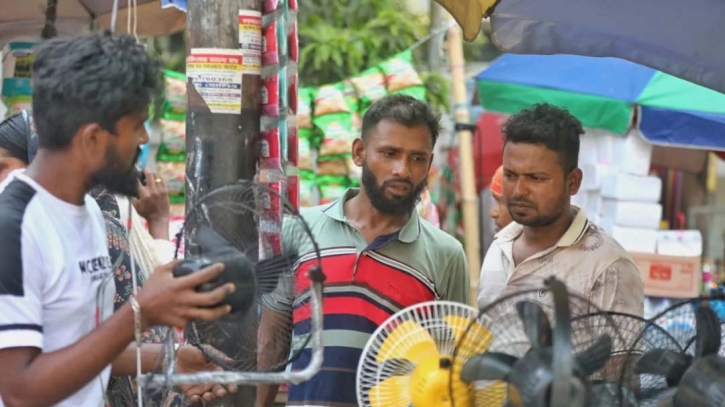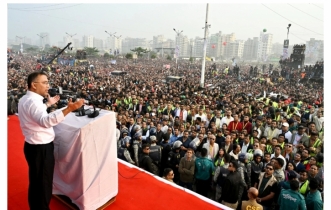
Staff Correspondent
The temperature exceeding 36? in larger areas of Bangladesh for longer periods of time has compelled meteorologists to issue heat alerts four times in April this year, with the country's southwest and central regions now reeling under a very severe heatwave.
Dr Muhammad Abul Kalam Mallik, a seasoned meteorologist working at the Bangladesh Meteorological Department (BMD), told Dhaka Tribune on Saturday that for the past 10 years or so, the duration of heatwave days (HWD) has been increasing in Bangladesh.
In an exclusive interview with Dhaka Tribune on Saturday, Dr Mallik said: "Ever since 2014, the duration of mild to moderate heatwave days has been on the rise. Now, we're experiencing very severe heatwaves this April and also observing a tendency of heatwaves not sweeping the southwest region only, but further shifting towards many central and southern districts."
He has been tracking the HWD trend for over the last three decades.
In a recently published scientific journal paper, Dr Mallik and his co-authors analyzed heatwaves of the 1990-2019 period to show that Jessore, Chuadanga, Rajshahi, Ishwardi, and Satkhira have been experiencing the highest numbers of heatwave days (20 to 30 days) during the pre-monsoon period (from March 1 to May 31).
Their study found that Bangladesh's capital, Dhaka, also experiences an average of 8.5 days of heatwaves during the pre-monsoon months, with the mercury shooting as high as 40.2? in the city on Saturday.
"In April, we had to issue heat alerts on the very first day of the month and then again on the 10th, 14th, and 19th," said Dr Mallik.
Severity of Heatwaves
When temperatures exceed 36? with a large area and linger for a minimum of three or more days, it can be considered a heatwave (HW).
There are four types of HW counted by the BMD – mild HW (36-37.9?), moderate HW (38-39.90?), severe HW (40-41.9?), and very severe HW (over 42?). On Saturday,Jessore experienced the country's highest temperature of this season (42.6?).
Why Heatwaves Strike Bangladesh
Dr Mallik and his co-authors' paper – "A Study on the Heatwave Conditions over Bangladesh" – published in the Journal of Engineering Science, explained: "In the pre-monsoon, the sun's rays drop down on the 'Thar' desert (India) and the foothill of the Himalayas vertically, creating a hot-tempered zone. That is why these regions produce a trough of low pressure, and there is a possibility of advection of temperature towards Bangladesh."
It further explained that the south/southwesterly wind carries a high amount of moisture over Bangladesh, and the heat capacity of moisture is higher than that of dry air. "Solar insulation, temperature advection, and moisture incursion are three main phenomena that are responsible for the HW condition."
Dr Mallik told Dhaka Tribune on Saturday that although the highest temperature recorded in Dhaka during the day was 40.4? on Saturday, people felt the heat up to 46? because of moisture and other factors.
He said they took records from all 34 stations in Bangladesh that kept heatwave readings for over the past three decades and found the highest numbers of HWD in Jessore (30.9 days).
Barisal had only 2.8 days of heatwaves during the March-May period, while Sylhet had only one day, and Comilla, Chittagong, and Cox's Bazar experienced even less than an average day of HWD.
He said: "April is the hottest month in Bangladesh, and the country experienced 17 heatwave days in April last year. This April too, we've experienced several days of heatwaves in the first week, and then we're in a second spell of continuous HWD since April 11."
Bangladesh Experiencing Higher Rise in Summer Temperature than Global Average
In recent years (2018-2022), Bangladesh has experienced a 0.9? rise in its summer temperature relative to the 1986-2005 baseline. That’s 0.2? higher than the global average increase in summer temperatures.
According to the 2023 Lancet report "Countdown on Health and Climate Change," there is only one country in South Asia that has witnessed a higher temperature rise than Bangladesh. That's Afghanistan (1.3?).
The average summer temperatures have increased in South Asia, increasing the time when it is too hot to work outside and the land area affected by drought.
The World Bank says that currently, the number of hours when it is too hot to work outside in Bangladesh is seven hours, but projections suggest that it might increase to eight hours by 2050.
According to the Lancet report, heat exposure-related loss in labor capacity resulted in average potential income losses equivalent to $863 billion globally in 2022, and agricultural workers were the most affected. Rising temperatures helped a 28.6% increase in the transmission potential for dengue by Aedes aegypti.





































